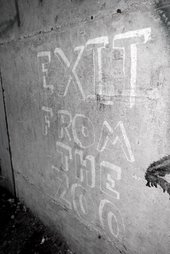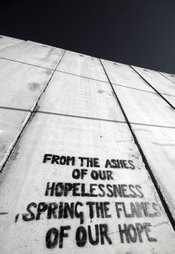Gaza
Bir Zeit is a quiet town nestled on two hills divided by a wide valley. In the evening, as the sun sets, warm red light bathes the competing hillsides in color. The falafel is good and the pita is cheap. Olive trees dot the surrounding landscape. Children play in the streets. Gaza is just a few dozen kilometers away, yet this place seems a world away. It feels free of violence. Perhaps even more comforting than its distance from the violence of Gaza is Bir Zeit’s refreshing absence of walls and checkpoints, soldiers and settlements.
That’s the thing about apartheid, the thing about cantons and separation-wealth and prosperity, violence and relative peace, oppression and freedom can exist side by side without much of an effect on one another. In the last few weeks we have received a number of emails and phone calls from family and friends expressing concern for our safety, of course in light of the recent turmoil in Gaza. What most people don’t understand is the level of separation between the West Bank and Gaza and even within the West Bank.
For all practical purposes the West Bank and Gaza might as well be on opposite sides of the world. It is nearly impossible for Palestinians and extremely difficult for internationals to visit Gaza at all. This stems from a common misconception about the situation in Gaza today: that it is in any sense an autonomous territory, the misconception that with the 2004 disengagement the occupation of Gaza ended. It is interesting to note that while the Western media hailed Prime Minister Ariel Sharon as a hero for peace with the unilateral disengagement from Gaza even the term "disengagement" partially exposes the reality of situation. The disengagement was not a withdrawal or a transfer of administrative power with the establishment and enforcement of self-determination in Gaza. It was a sly political move on Israel’s part to divert attention from its rapid colonial expansion in the West Bank as well as a response to the relative difficulty of internally occupying such a territory.
Gaza is grossly overcrowded and primarily desert-not exactly land worth annexing. The number of settlers in Gaza (around 10,000), pre-disengagement, paled in comparison to the over 400,000 settlers in the West Bank and East Jerusalem and the incentive of diverting international attention away from the West Bank far outweighed the difficulties of disengaging. What’s important to understand is that the disengagement was just that-a disengagement from internal occupation of Gaza to a cheaper external occupation. Today, Gaza is commonly accurately referred to as an "open-air prison."
Before the disengagement Gaza was under internal military occupation by the IOF (Israeli Occupation Forces). This, in addition to walls and checkpoints surrounding the territory and the fact the Israel controlled all travel into and out of Gaza as well as the sea on the western shore, and all trade into and out of Gaza. With the disengagement the situation in Gaza shifted from a direct military occupation alongside the illegal annexation of land through settlements to a more indirect canton style occupation. Israel still controls 100% of travel into and out of Gaza as well as trade and regulation of water use. Walls still surround Gaza and anyone, Palestinian or otherwise, still must apply for a permit, issued by the Israeli government, in order to enter Gaza. These are some of the daily controls exerted on the Palestinians of Gaza-many haven’t seen family that live just a short drive away in the West Bank for years. Some traveled to Gaza, leaving their families and ended up stranded, not allowed to exit Gaza. And still others were "deported" to Gaza for offenses as minor as being involved in a banned "political organization" or stone throwing. The dehumanization and repression of the Gazan Palestinians is one of the most explicit and barbaric human rights abuses taking place in the world today.
And then perhaps even more traumatic than the apartheid controls on Gaza are the frequent military incursions. This comes in various forms-direct military invasion, shelling, bombing, targeted assassinations, kidnappings, and regular sonic booms over crowded Gazan cities. The consequent physical and psychological trauma is massive. Children and innocent civilians are the primary victims of Israeli violence in Gaza.
At this point Gaza is under the control of Hamas-the Islamic movement that was democratically elected in January 2006. Almost immediately after the elections Israel and the West began a process of demonizing, sanctioning, imprisoning and assassinating the elected members of Hamas in addition to heavily supporting the Fatah movement (which was founded on a similar ethos as Hamas). The sanctions that followed the 2006 elections crippled the Palestinian economy and drove Hamas and other Islamic organizations to unprecedented levels of extremism. The most recent development was the dissolution of the recently formed unity (Hamas-Fatah) government alongside the formation of a disparate, Fatah controlled government in the West Bank. It does not look like things will get better in Gaza any time soon. Whatever one’s view on the policies of Hamas the events since January 2006 mark the beginning and the end of the first ever democratically elected Islamic movement. In any case the West along with Israel has proven that it has no interest in working to moderate Islamic political parties, democratically elected or not. It seems pro-Western/Israeli policy trumps democracy when it comes down to it.
Keep Gaza in your thoughts and prayers. There is a lot going on in Gaza today. There is a lot of violence, a lot of suffering and oppression, a lot of death. Hope for the violence to cease, the walls of oppression to fall, and life to be renewed.


No comments:
Post a Comment